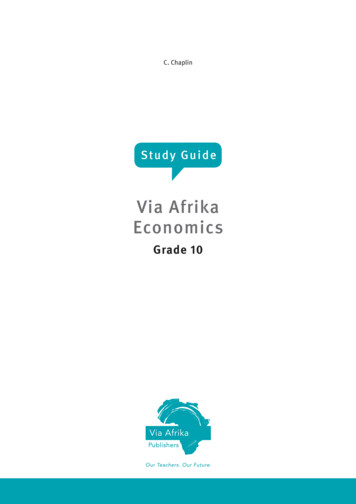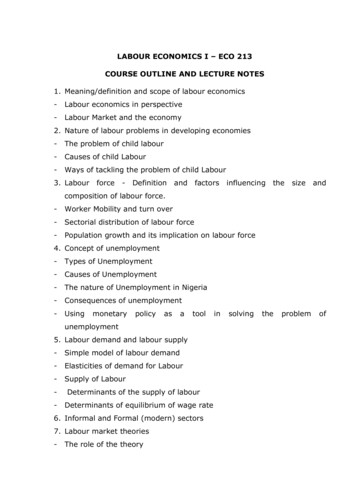
Transcription
scimoEconEDIUGSTUDYGRADE12
Department of Basic Education 2014EconomicsESTUDY GUIDGRADE12
Department of Basic Education 2014This content may not be sold or used for commercial purposes.Curriculum and Assessment Policy Statement (CAPS) Mind the Gap Grade 12Study Guide EconomicsISBN 978-1-4315-1949-1This publication has a Creative Commons Attribution NonCommercial Sharealikelicense. You can use, modify, upload, download, and share content, but youmust acknowledge the Department of Basic Education, the authors andcontributors. If you make any changes to the content you must send the changesto the Department of Basic Education. This content may not be sold or used forcommercial purposes. For more information about the terms of the license c-sa/3.0/.Copyright Department of Basic Education 2014222 Struben Street, Pretoria, South AfricaContact person: Dr Patricia WatsonEmail: watson.p@dbe.gov.zaTel: (012) 357 4502http://www.education.gov.zaCall Centre: 0800202933The first edition published in 2012 Revised National Curriculum Statement (RNCS)Mind the Gap Grade 12 Study Guide Economics ISBN 978-0-621-40910-9Second edition published in 2014 Curriculum and Assessment PolicyStatement (CAPS) Mind the Gap Grade 12 Study Guide Economics : ISBN978-1-4315-1949-1Mind the Gap teamSeries managing editor: Dr Patricia WatsonProduction co-ordinators for CAPS edition: Lisa Treffry-Goatley and Radha PillayAuthors: Richard Gouws, Janice Hardine, Andre Olivier, Nithiananthan Pillay, IrmelaRoodtExpert readers: Eugenia Maila, Maureen Mashinini, Neo Mejoane, MogalePhilemon Mochaki, Tammy Pike, Edwin Pretorius, Natalie WinterEditors: Julia Grey, Herbert OplandProofreader: Jenny de WetDesigners: Alicia Arntzen, Philisiwe Nkosi, Michele Dean, Nomalizo NgwenyaStudy skills: Margarita KarnasopoulosIllustrators: Michele Dean, Kenneth Kunene, Vusi Malindi, Bié VenterCover illustration: Alastair FindlayOnsite writers’workshop support: Wayne Cussons
Department of Basic Education 2014Ministerial forewordThe Department of Basic Education has pleasure in releasing the secondedition of Mind the Gap study guides for Grade 12 learners. These studyguides continue the innovative and committed attempt by the Departmentof Basic Education to improve the academic performance of Grade 12candidates in the National Senior Certificate (NSC) examination.The study guides have been written by subject expert teams comprisedof teachers, examiners, moderators, subject advisors and subject coordinators. Research started in 2012 shows that the Mind the Gap serieshas, without doubt, had a positive impact in improving grades. It is myfervent wish that the Mind the Gap study guides take us all closer towardsensuring that no learner is left behind, especially as we move forward inour celebration of 20 years of democracy.The second edition of Mind the Gap is aligned to the 2014 Curriculum andAssessment Policy Statement (CAPS). This means that the writers haveconsidered the National Policy pertaining to the programme, promotionrequirements and protocol for assessment of the National CurriculumStatement for Grade 12 in 2014.The Mind the Gap CAPS study guides take their brief in part from the 2013National Diagnostic report on learner performance and draws on the2014 Grade 12 Examination Guidelines. Each of the Mind the Gap studyguides provides explanations of key terminology, simple explanations andexamples of the types of questions that learners can expect to be asked inan exam. Marking memoranda are included to assist learners in buildingtheir understanding. Learners are also referred to specific questions inpast national exam papers and examination memos that are available onthe Department’s website – www.education.gov.za.The CAPS edition include Accounting, Economics, Geography, LifeSciences, Mathematics, Mathematical Literacy and Physical Sciences.The series is produced in both English and Afrikaans. There are alsonine English First Additional Language study guides. They include EFALPaper 1 (Language); EFAL Paper 3 (Writing); and a study guide for each ofthe Grade 12 prescribed literature set works.The study guides have been designed to assist those learners whohave been underperforming due to a lack of exposure to the contentrequirements of the curriculum and aims to mind-the-gap between failingand passing, by bridging the gap in learners’ understanding of commonlytested concepts so candidates can pass.All that is now required is for our Grade 12 learners to put in the hourspreparing for the examinations. Learners make us proud – study hard. Wewish each and every one of you good luck for your Grade 12 examinations.Matsie Angelina Motshekga, MPMinister of Basic EducationMay 2014Matsie Angelina Motshekga, MPMinister of Basic Education
Department of Basic Education 2014Table of ContentsDear Grade 12 learner.viiHow to use this study guide .xiTop 10 study tips .xiiQuestion words to help you answer questions.xiiiStudy skills to boost your learning .xiiiOn the day of the exam .xviLearner’s checklist .xviiiChapter 1: The circular flow model, national account aggregatesand the multiplier . 11.1 Key concepts .41.2 The open economy circular flow model.61.3 National account aggregates . 121.4 The multiplier . 19Chapter 2: Business cycles and forecasting . 232.1 Key concepts . 252.2 The composition and features of business cycles . 252.3 Explanations . 272.4 Government policy . 292.5 The new economic paradigm . 322.6 Features underpinning forecasting with regard to business cycles. 32Chapter 3: The role of the public sector . 373.1 Key concepts . 403.2 Composition and necessity. 413.3 Problems of public sector provisioning . 423.4 Objectives of the public sector and its budgets . 433.5 Fiscal policy . 463.6 Public sector failure . 48Chapter 4: The foreign exchange market and the balance ofpayments accounts . 514.1 Key concepts . 544.2 The reasons for international trade . 554.3 The balance of payments accounts . 564.4 Foreign exchange markets . 594.5 Establishment of foreign exchange rates . 614.6 Corrections of the balance of payments . 63Chapter 5: Protectionism and free trade . 675.1 Key concepts . 705.2 Export promotion . 715.3 Import substitution . 725.4 Protection . 735.5 Free trade.745.6 A desirable mix of protection and free trade . 755.7 Evaluation of South Africa’s trade policies . 76Chapter 6: The dynamics of perfect markets . 786.1 Key concepts . 816.2 Review of production, costs and revenue . 826.3 Perfect competition . 836.4 The individual business and the industry . 856.5 Market structures . 896.6 Output, profit, losses and supply . 906.7 How to draw graphs to show various equilibrium positions . 956.8 Competition policies . 96Chapter 7: Dynamics of imperfect markets . 997.1 Key concepts . 101 Department of Basic Education 2014Mind the Gap CAPS Grade 12 EconomicsCONTENTS v
Department of Basic Education 20147.27.37.47.57.6Monopolies . 102Output profit and loss. 104Oligopolies . 107Monopolistic competition . 110Summary of market structures . 111Chapter 8: The reasons for and consequences of market failures . 1158.1 Key concepts .1188.2 The reasons for market failures . 1198.3 Consequences/effects of market failures .1228.4 Cost-benefit analysis (CBA) .129Chapter 9: Economic growth and development . 1339.1 Key concepts .1359.2 Economic growth and economic development .1369.3 Demand-side approach .1369.4 The supply-side approach .1389.5 Evaluation of the South African approaches used in South Africa.1399.6 The North/South divide.141Chapter 10: South Africa’s industrial policies and their suitability interms of international best practice . 14510.1 Key concepts . 14710.2 Industrial development policies in South Africa . 14810.3 Regional development . 14910.4 South Africa’s endeavours .15010.5 Incentives to encourage industrial development. 15210.6 Appropriateness of South Africa’s industrial policies .15510.7 Appropriateness of South Africa’s regional development policies.15610.8 Small business development policies.15610.9 The appropriateness of black economic empowerment in the SouthAfrican economy .156Chapter 11: South African economic and social indicators . 15911.1 Key concepts . 16111.2 The performance of an economy . 16211.3 Economic indicators . 16211.4 Social indicators .16411.5 International comparisons . 166Chapter 12: Inflation . 17012.1 Key concepts . 17212.2 Measuring inflation (define, explain, examine) . 17312.3 Types and characteristics of inflation . 17312.4 The causes of inflation .17412.5 The consequences of inflation . 17612.6 Measures to combat inflation . 176Chapter 13: Tourism . 18013.1 Key concepts .18213.2 Definition of tourism .18313.3 The purposes of tourism .18313.4 Measuring tourism .18313.5 Reasons for growth .18313.6 The effects of tourism .18413.7 The benefits of tourism .18613.8 A South African tourism profile . 18713.9 Tourism policy suggestions . 187Chapter 14: Environmental sustainability. 19114.1 Key concepts .19314.2 The state of the environment .19414.3 Measures to ensure sustainability .196Appendix: Exemplar exam paper . 201 Department of Basic Education 2014vi CONTENTSMind the Gap CAPS Grade 12 Economics
Department of Basic Education 2014Dear Grade 12 learnerThis Mind the Gap study guide helps you to prepare for the end-of-yearCAPS Economics Grade 12 exam.The study guide does NOT cover the entire CAPS curriculum, but it doesfocus on core content of each knowledge area and points out where youcan earn easy marks.Education is the passport to thefuture, for tomorrow belongs to thosewho prepare for it today.You must work your way through this study guide to improve yourunderstanding, identify your areas of weakness and correct your ownmistakes. To ensure a good pass, you should also cover the remainingparts of the curriculum using other textbooks and your class notes. We areconfident that this Mind the Gap study guide can help you to prepare wellso that you pass the end-of-year exams.The importance of your success cannot be over-emphasised. You form partof the future generation, and we all hope for a better future, a future whereall our young South Africans can enjoy a high standard of living.Overview of the exam for CAPSEconomics Grade 12The Economics exam consists of TWO 1½ hour papers of 150 markseach. The paper consists of SIX questions divided into three sections.Question ONE is COMPULSORY. There are FIVE other questions from whichTHREE must be answered. The detailed requirements for each section areshown below:FORMAT OF THE GRADE 12 ECONOMICS QUESTIONPAPERS1. CLASSIFICATION OF TOPICS FOR GRADE 12 ECONOMICS QUESTIONPAPERSMIDYEAR EXAMINATION PAPERSThe two question papers are structured as follows:Economicsis a life journey Use it dailyECONOMICS GRADE 12PAPER 1150 MARKS – 1½ HOURSPAPER 2150 MARKS – 1½ HOURSMAIN TOPIC: MACROECONOMICSMAIN TOPIC:MICROECONOMICSTOPICS: Circular flow Business cycles Public sector Foreign exchange markets Protectionism and Free TradeTOPICS: Perfect markets Imperfect markets Market failures Department of Basic Education 2014Mind the Gap CAPS Grade 12 EconomicsINTRODUCTION vii
Department of Basic Education 2014TRIAL AND FINAL EXAMINATION PAPERSECONOMICS GRADE 12PAPER 1150 MARKS – 1½ HOURSPAPER 2150 MARKS – 1½ HOURSMAIN TOPIC:MACROECONOMICSMAIN TOPIC:MICROECONOMICSTOPICS: Circular flow Business cycles Public sector Foreign exchange markets Protectionism and Free TradeTOPICS: Perfect markets Imperfect markets Market failuresMAIN TOPIC:ECONOMIC PURSUITSMAIN TOPIC:ECONOMIC ISSUES Growth and Development Industrial development policiesPAY SPECIAL ATTENTIONNB Economic and socialperformance indicatorshint Inflation Tourism Environmental sustainabilityNBHINT! Eachpaper carries 150 MARKS The duration of each paper is 1½ HOURS Each paper comprises of SIX QUESTIONS divided into three sections. From the six questions only FOUR must be answered as follows:– SECTION A: Question 1 is COMPULSORYe.g.– SECTION B: Consists out of THREE questions: Questions 2–4 from which theEG - worked examplescandidate must choose only TWO– SECTION C: Consists out of TWO questions: Questions 5–6 from which theexamscandidate must choose only ONE The above papers must not be written on the same day. The detailed requirements for each section are indicated on the following pages:activityACTIVITIES boyand girl-left andright of pageactivityStep by stepcommentcomment Department of Basic Education 2014viii INTRODUCTIONMind the Gap CAPS Grade 12 Economics
Department of Basic Education 20141. DETAIL OF GRADE 12 ECONOMICS QUESTION PAPERSSECTION A (COMPULSORY)TOTAL: 30QUESTION 1 (TO BE ANSWERED IN THE ANSWER BOOK – NO LOOSEANSWER SHEETS ARE ALLOWED)1.1 Multiple-choice items (lower order)FOUR per main topic 8 items (2 marks per item)1.2 Matching column A and B (lower order)FOUR items per main topic 8 items (1 mark per item)1.3 Identify the concept (middle/lower order)THREE items per main topicSECTION B (Answer TWO QUESTIONS FROMTHIS SECTION)(8 2) (16)(8 1) (8)(6 1) (6)TOTAL: 80QUESTIONS 2 – 4 (THREE QUESTIONS)ONE question per MAIN TOPIC and ONE combination question (notnecessarily equally distributed) of the 2 MAIN TOPICS2.1 Short items2.1.1 Lower order(2 1) (2)2.1.2 Middle order(1 2) (2) (4)2.2 Data response (middle order): Study the following graph/cartoon/table/text, etc. and answer the questions that follow:(10)2.3 Data response (middle order): Study the following graph/cartoon/table/ text, etc. and answer the questions that follow:(10)2.4 ONE short question (middle order): (2 4) OR (4 2)(8)2.5 ONE short question (higher order): (2 4) OR (4 2)(8)[40]SECTION C (ANSWER ONE QUESTION FROMTHIS SECTION)TOTAL: 40QUESTIONS 5-6 (TWO ESSAY QUESTIONS) – ONE question per MAIN TOPICSTRUCTURE OF ESSAYIntroductionBody: Main part: Discuss in detail/Indepth discussion/Examine/Critically rentiate/Explain/Assess Additional part: Give own opinion/Critically discuss/Evaluate/Critically evaluate/Draw a graph and explain/Usethe graph given and explain/Complete the /InterpretConclusionTOTALMARKALLOCATIONMax. 2Max. 26Max. 10Max. 240 Department of Basic Education 2014Mind the Gap CAPS Grade 12 EconomicsINTRODUCTION ix
Department of Basic Education 2014Essays play a very big role in your success in Economics, because you mustchoose ONE essay to answer in each question paper, counting 40 marksout of the grand total of 150 marks. Each essay counts 40 marks. Thisstudy guide includes essay topics that have been asked in past questionpapers. Make sure that you study each of these topics in detail in yourpreparation for your preparatory and final papers.Never leave a question unanswered if you are asked to offer your ownopinion. Remember: each section includes questions that are easy andalmost-easy, so make sure you get these marks too.Good luck for your NSC exams, your doorway to a better future. Dream big,set your goals and go for it! Department of Basic Education 2014x INTRODUCTIONMind the Gap CAPS Grade 12 Economics
Department of Basic Education 2014Look out forthese icons in thestudy guide.How to use this study guide The study guide includes a table of keyNBconcepts with definitions NBwhich need to be learnt off by heart. You can gain easy marks forthe recall of definitions in the single mark questions.PAY SPECIAL ATTENTIONPAY SPECIAL ATTENTIONNBhintNBhint e.g.PAY SPECIAL ATTENTIONPay special g.examsNBHINT!Hints to help youHINT!remembera concept- worked examplesorEGguideyou insolving problemsNBhinte.g.examsEG - worked examplesRefers you to examquestionsPAY SPECIAL ATTENTIONNBHINT!EG - worked examplesWorked examplesActivities withquestions for youto answerexamsEG - worked examplesA checklist from the exam guidelines foractivityEconomics has beenprovided on page xvi for you to keep track of your progress.OnceACTIVITIESboyand girl-left andexamsyou have mastered the core concepts and have confidenceright of inpage youractivityanswers to the questions provided, tick thelast column of theactivityACTIVITIES boychecklist.and girl-left andactivityACTIVITIES boyand girl-left andright of pageactivityright of page activity Cover the answersThe activities are based on exam-type questions.activitycommentStep by stepand do the activity on yourown. Then check youranswers.commentRewardACTIVITIES boyand girl-left andyourself for the things youget right. If you get any incorrect answers,right of pagemake sure you understand where you went wrongbefore movingoncommentStep by stepcommentactivityto the next section. Each topic is briefly covered according to the exam guidelines.commentStep by stepcommentValuable guidelinesare providedto help you answer questionson graphs. Exemplar Exam papers are included in the study guide for you todo. Check your answers by looking back at your notes and the exammemoranda. An example of a paper goes a long way in preparingyou for what to expect and helps reduce exam anxiety. Go towww.education.gov.za to download more past exam papers.Step by stepcommentUse thisstudy guide as a workbook.Make notes, draw picturesand highlight importantconcepts.True individual freedom cannot exist without economic security and independence.Franklin D Roosevelt Department of Basic Education 2014Mind the Gap CAPS Grade 12 EconomicscommentINTRODUCTION xi
Department of Basic Education 2014Top 10 study tipsThe golden ruleof effective study isthe ABC – ApplyBottom to Chair!1.Have all your materials ready before you begin studying – pencils,pens, highlighters, paper, etc.2.Be positive. Make sure your brain holds onto the information you arelearning by reminding yourself how important it is to remember thework and get the marks.3.Take a walk outside. A change of scenery will stimulate your learning.You’ll be surprised at how much more you take in outside in thefresh air.4.Break-up your learning sections into manageable parts. Trying tolearn too much at one time will only result in a tired, unfocused andanxious brain.5.Keep your study sessions short but effective and reward yourselfwith short, constructive breaks.6.Teach your concepts to anyone who will listen. It might feel strangeat first, but it is definitely worth reading your revision notes aloud.7.Your brain learns well with colours and pictures. Try to use themwhenever you can.8.Be confident with the learning areas you know well and focus yourbrain energy on the sections that you find more difficult to take in.9.Repetition is the key to retaining information you have to learn. Keepgoing, don’t give up.10. Sleeping at least 8 hours every night, eating properly and drinkingplenty of water are all important things you need to do for your brain.Studying for exams is like tough exercise, so you must be preparedphysically. Department of Basic Education 2014xii INTRODUCTIONMind the Gap CAPS Grade 12 Economics
Department of Basic Education 2014Study skills to boostyour learningThis guide makes use of three study techniques you can use to help youlearn the material:1. Mobile notes2. Mnemonics3. Mind mapsMobile notesMobile notes are excellenttools for learning all the keyconcepts in the study guide.Mobile notes are easy tomake and you can takethem with you whereveryou go:1. Fold a blank piece ofpaper in half. Fold it inhalf again. Fold it again.2. Open the paper. It willnow be divided into 8parts.3. Cut or tear neatly alongthe folded lines.4. On one side, write thebasic concept.5. On the other side, writethe meaning or theexplanation of the basicconcept.6. Use different coloursand add pictures tohelp you remember.7. Take these mobilenotes with youwherever you go andlook at them wheneveryou can.8. As you learn, place thecards in three differentpiles: I know well Getting there I need morepractice9. The more you learnthem, the better youwill remember them.Thesemobile notes willhelp you studysmarter 1. Fold an A4 paper into8 squares. Cut or tearneatly along the foldedlines.YOLIGOPOL2. Write the basic concepton one side of a bit ofpaper.Market strucontrolled bctyuregroup of busia smallnesses.3. Write the definition ofthe basic concept onthe back of the piece ofpaper. Department of Basic Education 2014Mind the Gap CAPS Grade 12 EconomicsINTRODUCTION xiii
Department of Basic Education 2014MnemonicsA mnemonic code is a useful technique for learning information thatis difficult to remember.Look at pages42, 56, 184 and196 for somemore examples ofmnemonics.Here is a made-up word to help you remember the 6 reasons for marketfailure – EMILII – each letter of the word stands for a reason:E–ExternalitiesM–Missing marketsI– Imperfect competitionL– Lack of informationI– Immobility of factors of productionI– Imperfect distribution of income &wealthHere is a sentence to help you remember the 5 demand reasons forinternational trade – each word in the sentence begins with the sameletter as one of the reasons:PeopleInWitbankPopulationIncome WealthPreferCoffeePreferencesConsumptionMnemonics code information and make it easier to remember.The more creative you are and the more you link your ‘codes’ to familiarthings, the more helpful your mnemonics will be.This guide provides several ideas for using mnemonics. Be sure to makeup your own. Department of Basic Education 2014xiv INTRODUCTIONMind the Gap CAPS Grade 12 Economics
Department of Basic Education 2014Mind mapsThere are several mind maps included in this study guide, which summarisesome of the sections.Have a look at the following pictures of a brain cell (neuron) and a mindmap:Figure 1: Brain cell or neuronFigure 2: Mind map rulesMind maps work because they show information that we have to learn inthe same way that our brains ‘see’ information.As you study the mind maps in the g
Mind the Gap CAPS Grade 12 Economics INTRODUCTION vii Dear Grade 12 learner This Mind the Gap study guide helps you to prepare for the end-of-year CAPS Economics Grade 12 exam. The study guide does NOT cover the entire CAPS curriculum, but it does focus on core content of each knowledge area and points out where you can earn easy marks.









